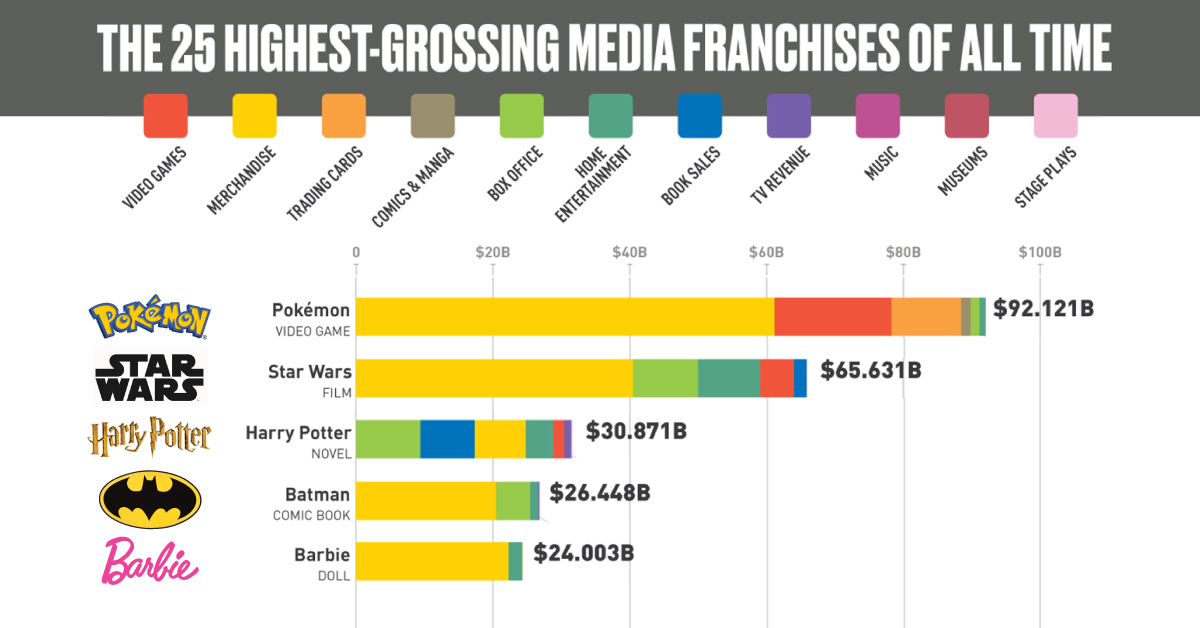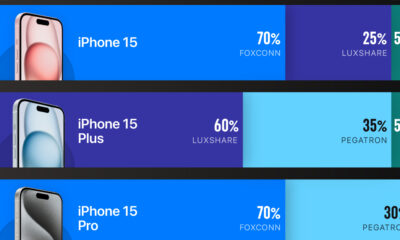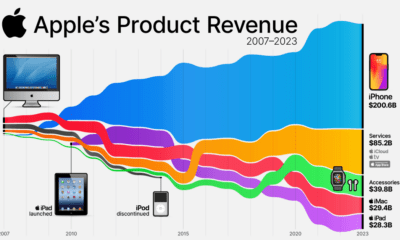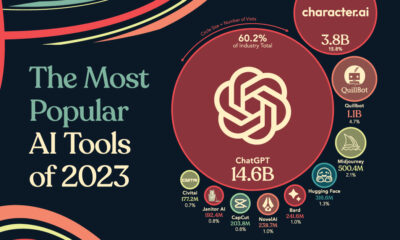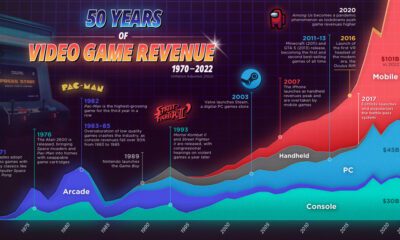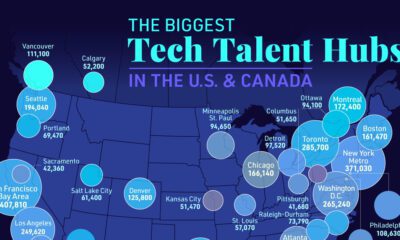Technology
The World’s 25 Most Successful Media Franchises, and How They Stay Relevant

The World’s 25 Most Successful Media Franchises, and How They Stay Relevant
Great stories come and go, but there are a certain few that can truly stand the test of time.
Tugging on the heartstrings with nostalgic stories can be a powerful tool. Yet, even the most world-renowned storytellers like Disney face pressure to constantly innovate.
Today’s infographic from TitleMax illustrates the highest-grossing media franchises, and dives into how they generate their revenue and adapt to new mediums in changing times.
The Supreme Storytellers
According to the infographic, the majority of franchise revenue comes from merchandising. Video games, comic books, and Japanese manga are also significant drivers of income.
| Rank | Franchise | Year Created | Revenue (USD) | Main Revenue Source |
|---|---|---|---|---|
| #1 | Pokémon | 1996 | $92B | Merchandise |
| #2 | Hello Kitty | 1974 | $80B | Merchandise |
| #3 | Winnie the Pooh | 1924 | $75B | Merchandise |
| #4 | Mickey Mouse | 1928 | $70B | Merchandise |
| #5 | Star Wars | 1977 | $66B | Merchandise |
| #6 | Anpanman | 1973 | $60B | Merchandise |
| #7 | Disney Princesses | 2000 | $45B | Merchandise |
| #8 | Mario | 1981 | $36B | Video Games |
| #9 | Jump Comics | 1968 | $34B | Comics and Manga |
| #10 | Harry Potter | 1997 | $31B | Box Office |
| #11 | Marvel Cinematic Universe | 2008 | $29B | Box Office |
| #12 | Spiderman | 1962 | $27B | Merchandise |
| #13 | Gudam | 1979 | $26B | Merchandise |
| #14 | Batman | 1939 | $26B | Merchandise |
| #15 | Dragonball | 1984 | $24B | Comic and Manga |
| #16 | Barbie | 1959 | $24B | Merchandise |
| #17 | Fist of The North Star | 1983 | $22B | Video Games |
| #18 | Cars | 2006 | $22B | Merchandise |
| #19 | Toy Story | 1995 | $20B | Merchandise |
| #20 | One Piece | 1997 | $20B | Comics and Manga |
| #21 | Lord of The Rings | 1937 | $20B | Book Sales |
| #22 | James Bond | 1953 | $20B | Box Office |
| #23 | Yu-Gi-Oh | 1996 | $20B | Trading Cards |
| #24 | Peanuts | 1950 | $17B | Merchandise |
| #25 | Transformers | 1984 | $17B | Merchandise |
Perhaps surprisingly, Marvel is not included in the top 10. Despite nearly $30 billion revenue and a long history rooted in comic books, the entertainment behemoth still has much ground to cover as the newest franchise in the ranking.
Reinventing a Classic
While the list proves that success builds over time, these classics need to constantly reinvent themselves as their audiences become reliant on new technologies and demand more immersive experiences.
Pokémon
As the highest grossing media franchise earning roughly $4 billion a year, Pokémon’s strength lies in it ability to adapt to new technology.
The Japanese phenomenon has continued to reposition itself since it first introduced Pokémon cards in 1996. These days, the franchise is perhaps best known for bringing augmented reality to the masses with Pokémon Go—an app that attracted 50 million users in just 19 days.
Hello Kitty
Yet another Japanese brand tops the list of media franchises. With 50,000 product lines available in over 130 countries and cumulative revenue of $80 billion, Hello Kitty is famous for harnessing the power of cute.
The fictional character has evolved into a globally recognized symbol as a result of big name partnerships and licensing deals with the likes of Puma, Asos and Herschel—and is etched onto almost every type of accessory thinkable.
More recently, the brand announced its foray into video games, and will collaborate with the global esports organization FNATIC on content and merchandise.
Winnie the Pooh
The chronicles of Winnie the Pooh have transcended time by providing a connection to the innate wonder of childhood.
Originally created following World War I, the newest movie rendition “Christopher Robin” became the highest-grossing film in the franchise, grossing $197 million worldwide.
Mickey Mouse
With 97% brand name recognition, Mickey Mouse is officially more recognizable than Santa Claus. Similarly to Winnie the Pooh, Disney introduced Mickey Mouse as a symbol of hope following the World War.
Over 90 years later, global brands such as L’oreal, Beats, Uniqlo and more recently, Gucci are paying homage. In 2019, the luxury fashion brand licensed the Mickey Mouse image for a 3D printed bag worth $4,500, making it even more of a ubiquitous symbol of pop culture.
Star Wars
Another Disney favorite, Star Wars holds the title of most successful movie franchise, with cumulative revenues of $65 billion.
The franchise successfully appeals to a multi-generational audience by mixing old characters with new storylines, such as ‘The Mandalorian’, broadcasting on the new streaming service Disney+—hailed as one of the more exciting moves to come from the saga.
Making Magic
Disney owns three out of the top five highest grossing franchises, so it comes as no surprise that the media conglomerate is investing heavily in digital innovation to provide a more immersive customer experience.
In fact, every franchise in the ranking relies on multiple touchpoints and revenue streams to create a more interactive and emotional experience for their audience.
By harnessing a compelling combination of both imagination and technology, Disney and other top global franchises can continue to lead in the business of making magic.
Technology
All of the Grants Given by the U.S. CHIPS Act
Intel, TSMC, and more have received billions in subsidies from the U.S. CHIPS Act in 2024.

All of the Grants Given by the U.S. CHIPS Act
This was originally posted on our Voronoi app. Download the app for free on iOS or Android and discover incredible data-driven charts from a variety of trusted sources.
This visualization shows which companies are receiving grants from the U.S. CHIPS Act, as of April 25, 2024. The CHIPS Act is a federal statute signed into law by President Joe Biden that authorizes $280 billion in new funding to boost domestic research and manufacturing of semiconductors.
The grant amounts visualized in this graphic are intended to accelerate the production of semiconductor fabrication plants (fabs) across the United States.
Data and Company Highlights
The figures we used to create this graphic were collected from a variety of public news sources. The Semiconductor Industry Association (SIA) also maintains a tracker for CHIPS Act recipients, though at the time of writing it does not have the latest details for Micron.
| Company | Federal Grant Amount | Anticipated Investment From Company |
|---|---|---|
| 🇺🇸 Intel | $8,500,000,000 | $100,000,000,000 |
| 🇹🇼 TSMC | $6,600,000,000 | $65,000,000,000 |
| 🇰🇷 Samsung | $6,400,000,000 | $45,000,000,000 |
| 🇺🇸 Micron | $6,100,000,000 | $50,000,000,000 |
| 🇺🇸 GlobalFoundries | $1,500,000,000 | $12,000,000,000 |
| 🇺🇸 Microchip | $162,000,000 | N/A |
| 🇬🇧 BAE Systems | $35,000,000 | N/A |
BAE Systems was not included in the graphic due to size limitations
Intel’s Massive Plans
Intel is receiving the largest share of the pie, with $8.5 billion in grants (plus an additional $11 billion in government loans). This grant accounts for 22% of the CHIPS Act’s total subsidies for chip production.
From Intel’s side, the company is expected to invest $100 billion to construct new fabs in Arizona and Ohio, while modernizing and/or expanding existing fabs in Oregon and New Mexico. Intel could also claim another $25 billion in credits through the U.S. Treasury Department’s Investment Tax Credit.
TSMC Expands its U.S. Presence
TSMC, the world’s largest semiconductor foundry company, is receiving a hefty $6.6 billion to construct a new chip plant with three fabs in Arizona. The Taiwanese chipmaker is expected to invest $65 billion into the project.
The plant’s first fab will be up and running in the first half of 2025, leveraging 4 nm (nanometer) technology. According to TrendForce, the other fabs will produce chips on more advanced 3 nm and 2 nm processes.
The Latest Grant Goes to Micron
Micron, the only U.S.-based manufacturer of memory chips, is set to receive $6.1 billion in grants to support its plans of investing $50 billion through 2030. This investment will be used to construct new fabs in Idaho and New York.
-

 Debt1 week ago
Debt1 week agoHow Debt-to-GDP Ratios Have Changed Since 2000
-

 Markets2 weeks ago
Markets2 weeks agoRanked: The World’s Top Flight Routes, by Revenue
-

 Countries2 weeks ago
Countries2 weeks agoPopulation Projections: The World’s 6 Largest Countries in 2075
-

 Markets2 weeks ago
Markets2 weeks agoThe Top 10 States by Real GDP Growth in 2023
-

 Demographics2 weeks ago
Demographics2 weeks agoThe Smallest Gender Wage Gaps in OECD Countries
-

 United States2 weeks ago
United States2 weeks agoWhere U.S. Inflation Hit the Hardest in March 2024
-

 Green2 weeks ago
Green2 weeks agoTop Countries By Forest Growth Since 2001
-

 United States2 weeks ago
United States2 weeks agoRanked: The Largest U.S. Corporations by Number of Employees

